| Organic Seeds | Edible Plants | Organic Pest Controls | Books | Tools, Propagation & Fertilisers | Sprouting & Microgreens | Poultry Supplies | Specials & Gift Ideas |

Top

We will send an email to this address*
when is next available
* we will use this email address only for this notification and then we will delete it.
 Home
Home
Green Harvest Organic Gardening Supplies is permanently closed as of 5pm on 1-11-2023.
We will not be taking orders by this website, in person, by phone or email. Our display garden and retail shop are closed forever.
Read more...
Phone:07 54357000
Phone calls will only be responded to sporadically and only in reference to orders placed prior to 2-11-2023. All the useful growing and organic pest management research and resources are available on this website for a while still.
|
|
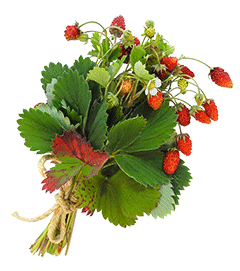 Alpine Strawberry 'Baron Solemacher'
UT
Alpine Strawberry 'Baron Solemacher'
UTFragaria vesca var. vesca Syn. Fraises des Bois, wild strawberry. 'Baron Solemacher' is a German heirloom alpine strawberry bred from the woodland strawberries that have been grown in home gardens since the 12th century. It is an early fruiting type, producing dainty clusters of deep red, sweet and juicy berries, which can be up to 25 mm in diameter, weighing 3 to 5 g. The fruit is incredibly sweet and aromatic, growing in abundance on compact, bushy plants. It is a perfect choice for growing in containers or hanging baskets. Alpine strawberries can grow in full sun, although in very hot areas, they do better in dappled shade. Like other strawberries, they do best in a rich, fertile, well-drained soil. The plants are hardy and unlike other strawberries, they do not send out runners. Instead they grow as a leafy mound to 30 cm in height. Plants bear fruit the first season after planting. Feed and water regularly and they will continue to fruit for 2 to 4 years, after that they can be rejuvenated by division. Alpine strawberries are best grown in temperate or cooler subtropical areas. SS393 (approx. 200 seeds per pkt.) SS394 (approx. 5500 seeds per pkt.) Alpine Strawberry plants are available seasonally. |
 Alpine Strawberry 'Rujana'
UT
Alpine Strawberry 'Rujana'
UTFragaria vesca var. vesca Syn. 'Rjugen', 'Rugia', 'Ruegen', 'Rugen', Fraises des Bois, wild strawberry 'Rujana' is a German heirloom alpine strawberry bred in 1920 and was one of the first cultivars selected. It has large, white flowers followed by a heavy crop of sweet red fruit with a beautiful fragrance. The fruit can be dried and makes an unforgettable jam! The leaves and fruit can be used for herbal tea. The berries have wider shoulders and are larger than other alpine types. It is a perfect choice for growing in containers or hanging baskets or as an edging plant along pathways. Alpine strawberries are cultivated versions of the woodland strawberries that have been grown in home gardens since the 12th century. Alpine strawberries can grow in full sun, although in very hot areas, they do better in dappled shade. Like other strawberries, they do best in a rich, fertile, well-drained soil. The plants are hardy and unlike other strawberries, they do not send out runners. Instead they grow as a leafy mound to 30 cm in height. Plants bear fruit the first season after planting. Feed and water regularly and they will continue to fruit for 2 to 4 years, after that they can be rejuvenated by division. Alpine strawberries are best grown in temperate or cooler subtropical areas. SS181 (approx. 200 seeds per pkt.) SS182 (approx. 5500 seeds per pkt.) Alpine Strawberry plants are available seasonally. |
|
Amaranth Leaf syn. Leaf Amaranth; Chinese Spinach, Tampala, bayam
Amaranthus tricolor A nutritious, leafy green for warmer areas. It is a fast-growing and best to harvest the whole plant as older plants get tough and bitter tasting. Successive sowings will provide greens over a long period. The leaves have a sweet, tangy flavour and are best cooked, raw leaves should not be eaten very often, as they are high in nitrates and oxalic acid. In China and Japan it is the main vegetable used as a cooked green. Leaf Amaranth prefers a fertile, well-drained garden soil, full sun to partial shade. Soil temperature needs to be at least 20°C to germinate seed, sow late spring and summer. Harvest is 30 days to baby leaf and 50 days to maturity, when they are about 20 cm tall. As they get older the leaves will get tougher. |
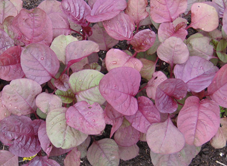 Amaranth 'Red'
H
OG
Amaranth 'Red'
H
OG'Red' is a very attractive, nutritious, red leafy green for warmer areas. SA124 (approx. 250 seeds per pkt.) SA125 |
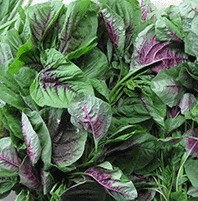 Amaranth 'Red Calaloo'
H
UT
Amaranth 'Red Calaloo'
H
UTSyn. Red Stripe Leaf Red Calaloo has attractive green leaves with a red splash down the middle. SA112 (approx. 250 seeds per pkt.) SA113 SA149 SA107 |
|
Angled Luffa
 syn. Okra Vine, Okra Cee Gwa Luffa acutangula Angled Luffa is a fast growing, vigorous annual vine that requires a trellis to grow on. The young fruits are similar in flavour to zucchini but slightly sweeter, it is a good substitute for zucchini in humid areas as it does not suffer fungal problems. The stem tops, young leaves and flower buds can be steamed as vegetables and the seeds from mature fruit roasted with salt and eaten. Plant it in a rich soil in full sun. Sow seed in spring. See also Luffa - Loofah |
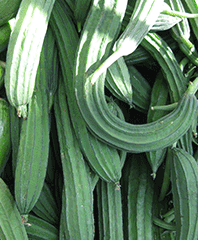
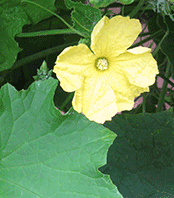 Angled Luffa
H
Angled Luffa
H
 UT
UTSA109 (approx. 12 seeds per pkt.) SA110 |
|
Globe Artichoke
Cynara scolymus Globe artichoke is an herbaceous perennial to 1.5 m high, suitable for temperate, Mediterranean climates. The edible flower buds are a delicacy, pick them before they start to open. The striking grey-green foliage and spectacular flowers add beauty to the garden. Globe artichoke has a restricted climatic range and prefers cool, moist summers and mild winters. Chilling is needed to produce buds. A deep, rich, well-drained, alkaline soil is required; artichokes will grow in a pH range of 6.5 - 7.5. Compost and manures are beneficial. Sow spring in temperate areas. Globe artichoke needs to be dug and divided every 3-4 years. Unsuitable for tropical and Subtropical areas Growing in humid, subtropical and tropical areas is very difficult. Unfortunately even if the plants grow well, insufficient chilling will make bud production unlikely or of very poor quality. High temperatures in spring will also cause the flower buds to open prematurely. Plants will be short-lived, often collapsing during periods of heavy rain. If artichokes are on your 'most desired' list then try the 'Imperial Star' variety as they begin cropping early. Enthusiasts in warmer areas dig the roots and put them in the fridge during the summer for planting in the autumn. Excellent drainage is required and raised beds will help. |
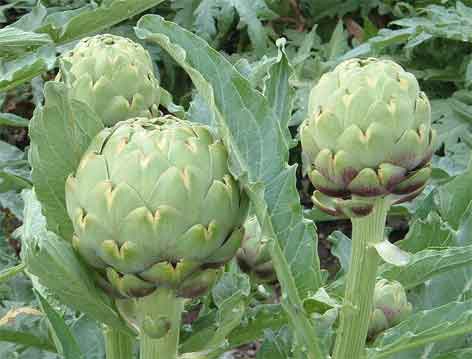 Globe Artichoke - Green Globe
UT
Globe Artichoke - Green Globe
UTThis is an improved artichoke strain suitable for the home garden. The mature flower buds are globe-shaped and are an attractive deep green without the purple tinge. There are virtually no sharp spines on the leaves or buds, making it much easier to harvest. The fleshy base of the petals and the meaty heart are the most edible parts. Buds are usually cut when 6 - 10 cm in diameter. These vigorous and prolific plants grow up to a height of 1.8 m and will produce the first year from seed. SA102 (approx. 10 seeds per pkt.) SA117 SA153 |
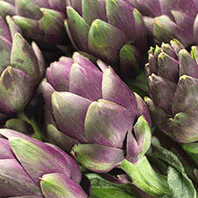 Globe Artichoke 'Violet Star'
UT
Globe Artichoke 'Violet Star'
UT'Violet Star' produces beautiful violet-purple, round and slightly conical globe artichokes on large vigorous plants to 90 cm tall. A gourmet vegetable producing abundant yields of tender artichokes and is an excellent choice for the home garden. Days to harvest: 85 SA150 (approx. 10 seeds per pkt.) SA151 |
|
Asparagus
Asparagus officinalis Asparagus is a herbaceous ferny perennial to 1.5 m high, asparagus has both male and female plants. Sow seed in seedling trays in early spring, 5 mm deep at 25°C soil temperature. Germination will take approximately 21 days. Plant out in full sun in a deep, rich, well-drained, soil, compost and manures are beneficial. The pH of the soil should be 6.5, lime if necessary. After the 1st year, remove female berry-bearing plants as the berries will germinate and choke the bed if left. Care should be taken to avoid harvesting the first few years, to allow the crowns to build strength. More growing information... |
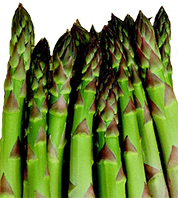 Asparagus 'Connover's Colossal'
UT
Asparagus 'Connover's Colossal'
UTAsparagus 'Connover's Colossal' is an American heirloom from the 1870's distinctive for its very thick spears, up to 3.8 cm (1½") across at the base. It produces an excellent yield of bright green spears tinged with purple at the tips with wonderful flavour raw or cooked. It has thick, large, ferny leaves and is an early maturing variety. SA134 (approx. 20 seeds per pkt.) SA135 (approx. 300 seeds per pkt.) |
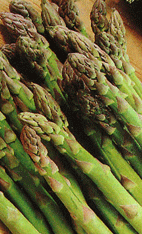 Asparagus 'Mary Washington'
UT
Asparagus 'Mary Washington'
UT'Mary Washington' produces thick, straight, dark green spears tinged with purple at the tightly folded tips; wonderful flavour raw or cooked. SA111 (approx. 20 seeds per pkt.) SA115 (approx. 300 seeds per pkt.) SA126 Crowns are available seasonally. |
 Asparagus 'Sweet Purple'
UT
Asparagus 'Sweet Purple'
UT'Sweet Purple' asparagus has large, deep-burgundy spears which are very tender with a mild, nutty flavour when cooked. The spears are much more tender than green asparagus because the vascular bundles have less lignin per spear, which make the spears less stringy. This allows the cook to use the entire spear with very little waste. It also has a 20% higher sugar content. Because of this extra sweetness, this vegetable is often eaten raw. Some restaurants like to garnish salads with purple asparagus. SA103 (approx. 20 seeds per pkt.) SA118 (approx. 300 seeds per pkt.) SA121 Crowns are available seasonally. |
 Asparagus 'UC 157'
UT
Asparagus 'UC 157'
UT'UC 157' is the most widely planted fresh market asparagus variety in the world. It was developed at University of California in 1978. It is known for very high yield and disease resistance. The delicious, smooth green spears are tight tipped, non-stringy and uniform in colour and size. Plants may take up to 2 - 3 years to come to full production but can bear for 15 - 20 years. This is an F1 hybrid so is not suitable for seed saving. SA116 (approx. 20 seeds per pkt.) SA147 (approx. 300 seeds per pkt.) SA152 Crowns are available seasonally. |
|
|
At Green Harvest we are passionate about open-pollinated, heirloom seed as we believe it is a resource belonging to all people,
not a product to be exploited by a few. Open-pollinated vegetable seeds are genetically diverse treasures that have been passed
on from generation to generation of gardeners. We invite you to contact us
if you would like to help us preserve open-pollinated seed varieties in Australia.
More information on seed saving...
|
Green Harvest specialises in seeds which are:
|
A
free
Successful Seed Raising Guide is included with your first seed order from Green Harvest.
Seed to WA:
A $6.95 Quarantine Fee will be charged for all seed orders to WA. Green Harvest is sharing the cost of
the quarantine fee with all our WA customers.
Read more...
 Home
Home
Green Harvest Organic Gardening Supplies is permanently closed as of 5pm on 1-11-2023.
We will not be taking orders by this website, in person, by phone or email. Our display garden and retail shop are closed forever.
Read more...
Phone:07 54357000
Phone calls will only be responded to sporadically and only in reference to orders placed prior to 2-11-2023. All the useful growing and organic pest management research and resources are available on this website for a while still.
We guarantee our seeds to the value of the purchase price. We are happy to replace the seeds, give you a credit or refund, whichever you prefer. Other than our guarantee to the extent of the purchase price Green Harvest gives no other warranty expressed or implied. No liability will be accepted by Green Harvest, its owners or employees as to the accuracy of any information. No responsibility will be taken for damage to property or persons due to information given about a product or technique. No responsibility will be taken for the loss of a crop or income due to information given about a product or technique.
 Shopping here is private and secure.
Shopping here is private and secure.
Copyright © 2001 - 2024 Green Harvest Organic Gardening Supplies
No part of this website may be reproduced without permission of the owner

